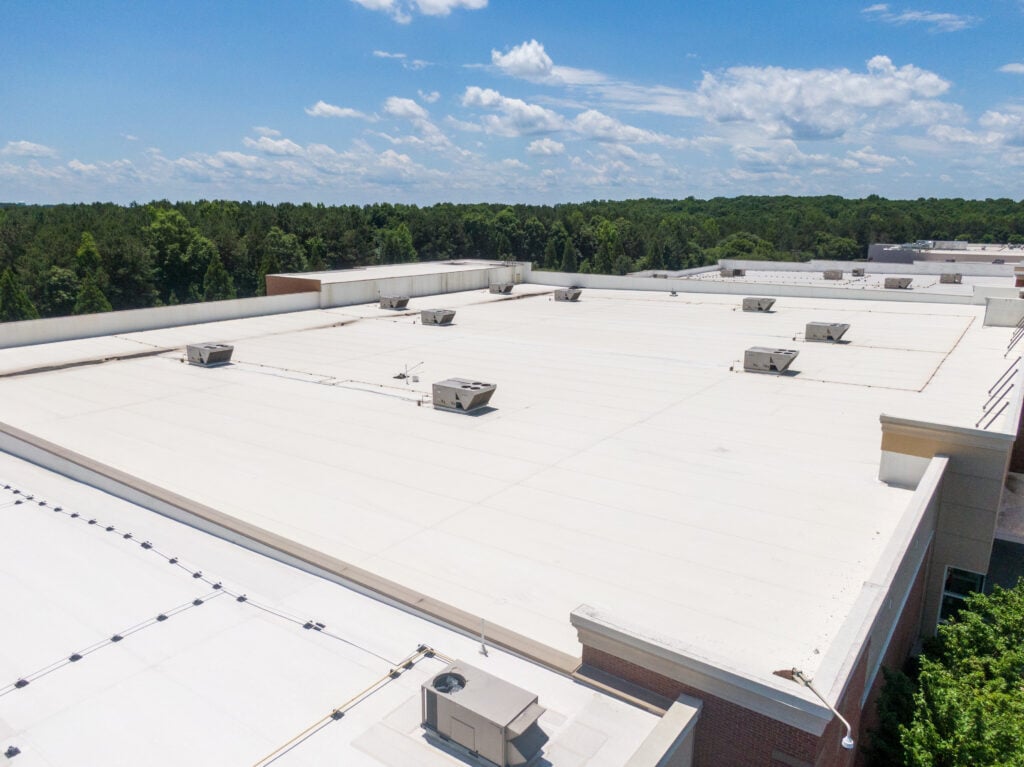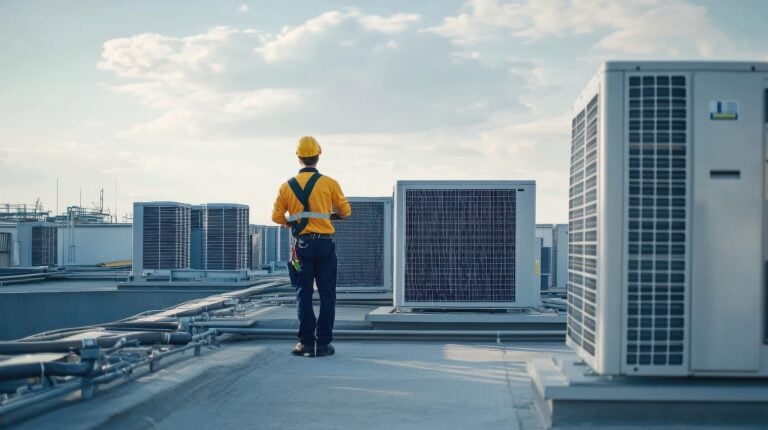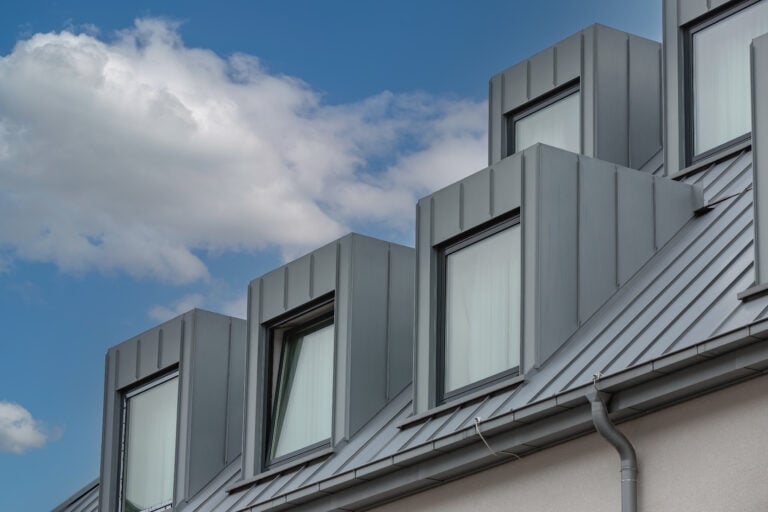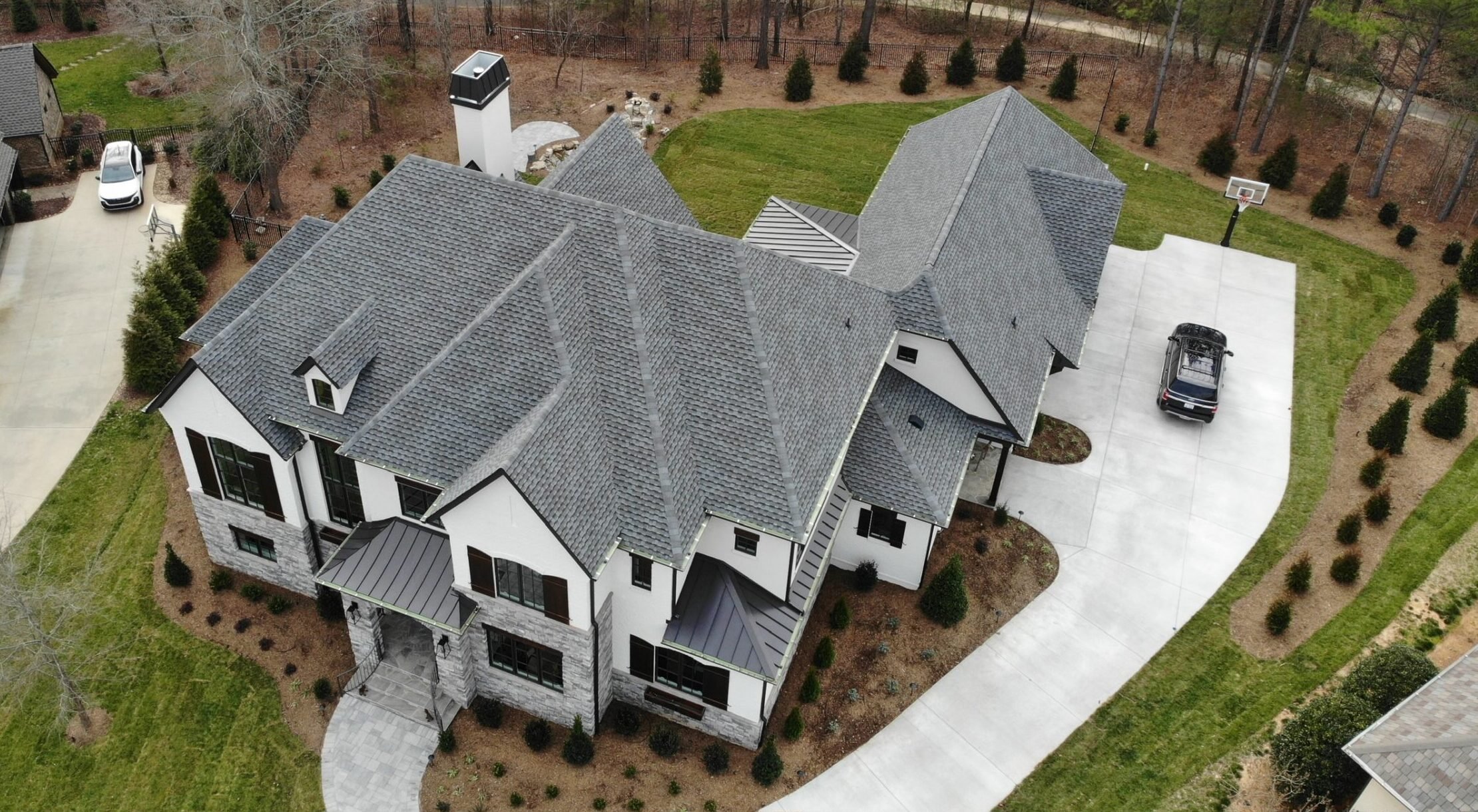What Is TPO Roofing? (7 Reasons to Choose TPO In 2025)
Posted 6.12.25 | 7 Minute Read

If you’re exploring commercial roofing options, you’ve likely come across TPO roofing. This single-ply membrane has gained significant popularity among business owners and property managers over the past decade. But what exactly is TPO roofing, and why should you consider it for your commercial building?
This comprehensive guide will walk you through everything you need to know about TPO roofing systems. We’ll explore what TPO roofing is, examine its key benefits, discuss installation considerations, and help you determine if it’s the right choice for your commercial property. Whether you’re planning a new roof installation or considering a replacement, this information will help you make an informed decision about your roofing investment.
- What is TPO roofing?
- 7 reasons to choose TPO roofing in 2025
- TPO vs. other commercial roofing materials
🤔 What Is TPO Roofing?

TPO stands for Thermoplastic Polyolefin, a single-ply roofing membrane designed specifically for flat and low-slope commercial roofs. This synthetic roofing material consists of a blend of polypropylene and ethylene-propylene rubber, creating a durable and flexible membrane that can withstand various weather conditions.
TPO roofing membranes typically range from 45 to 80 mils in thickness, with 60-mil being the most common choice for commercial applications. The material comes in large sheets that are heat-welded together during installation, creating a seamless, watertight barrier across your entire roof surface.
TPO Roofing Components
A complete TPO roofing system includes several essential components:
- TPO Membrane: The primary waterproof layer that protects your building
- Insulation: Provides thermal resistance and energy efficiency
- Cover Board: Protects the insulation and membrane from damage
- Fasteners: Secure the system to the roof deck
- Flashing: Seals penetrations and roof edges
- Walkway Pads: Protect high-traffic areas
👉 7 Reasons to Choose TPO Roofing in 2025

TPO roofing is gaining popularity in 2025 for its energy efficiency and durability. It’s a cost-effective solution that helps reduce utility bills while providing long-lasting protection.
1. Energy Efficiency and Cost Savings
TPO roofing is renowned for its energy-efficient properties, making it an excellent choice for businesses looking to reduce energy costs. Its reflective white surface is designed to bounce back solar radiation, which can significantly lower the heat absorbed by your building. This means less reliance on your HVAC system to keep interiors cool, leading to potential reductions in cooling costs of up to 30%. Additionally, TPO is Energy Star-qualified, ensuring its effectiveness in minimizing energy usage. Many utility companies also recognize the benefits of energy-efficient roofing systems like TPO and may offer rebates or incentives to encourage installation. Over time, these savings can add up, making TPO roofing a cost-effective investment for energy-conscious businesses.
2. Durability and Weather Resistance
Modern TPO roofing systems are engineered to handle even the toughest weather conditions, making them a reliable option for long-term roof protection. TPO membranes are highly resistant to:
- High Winds: Withstand wind speeds of up to 120 mph, providing peace of mind in areas prone to storms or hurricanes.
- Hail: Designed to resist impact damage, even from large hailstones.
- UV Radiation: Built to handle prolonged exposure to the sun without cracking or degrading, making it perfect for sunny climates.
- Temperature Fluctuations: Maintains strength and flexibility in both extreme heat and freezing temperatures, preventing cracking or expansion issues.
- Chemical Exposure: Resistant to industrial pollutants, grease, and oil, which can otherwise damage traditional roofing materials.
Most TPO roofing systems come with warranties ranging from 15 to 30 years, ensuring long-term durability. This durability translates to fewer repairs and less worry, making it a smart choice for business owners looking to protect their investment.
3. Cost-Effective Installation
TPO roofing provides exceptional value compared to many other commercial roofing materials. The cost of TPO membranes is generally lower than that of PVC or modified bitumen systems, making it a budget-friendly option. Additionally, its installation process is streamlined and efficient. TPO membranes are manufactured in large sheets, which minimize seams and reduce labor time during installation. Heat-welding technology used in TPO installation ensures strong, watertight seams, further increasing efficiency. By combining lower material costs with faster installation times, TPO roofing offers businesses significant savings without sacrificing quality.
4. Environmentally Friendly
If sustainability is a priority, TPO roofing is an environmentally responsible choice. At the end of its service life, TPO roofing is 100% recyclable, ensuring minimal waste ends up in landfills. The manufacturing process is designed to produce limited waste, further reducing its environmental footprint. Additionally, the energy-efficient properties of TPO contribute to lower energy consumption, which reduces overall carbon emissions from your building. By choosing TPO, you’re not only saving money but also doing your part to support a greener planet.
5. Low Maintenance Requirements
TPO roofing offers the benefit of minimal maintenance, making it a hassle-free choice for business owners. Once installed, its smooth and durable surface naturally resists dirt, debris, and algae buildup, which keeps your roof looking clean and functioning effectively. Routine inspections and basic upkeep, such as clearing debris or checking seams, can go a long way in extending the life of your roof. Unlike some roofing systems that require frequent repairs or intensive maintenance, TPO is designed to be low-effort while still delivering excellent performance for decades.
6. Versatile Installation Options
One of the standout features of TPO roofing is its versatility when it comes to installation methods. Contractors can choose from three main options, depending on your building’s specific needs:
- Mechanically Attached: The membrane is fastened directly to the roof deck using screws and plates, providing strong wind resistance and making it ideal for areas with high winds.
- Fully Adhered: Adhesive is used to bond the TPO membrane to the substrate, enhancing durability and resistance to wind uplift. This method also provides a smooth, aesthetically pleasing finish.
- Ballasted: The membrane is held down with gravel or pavers, offering a quick and cost-effective method for flat roofs.
This flexibility allows roofing contractors to tailor the installation method to your building’s structure, climate conditions, and specific requirements, ensuring the best possible results.
7. Proven Track Record
TPO roofing has a well-established history of success in commercial applications, providing over 25 years of reliable performance. Continuous advancements in TPO formulation and installation techniques have resulted in a mature, dependable roofing system trusted by businesses worldwide. Its proven ability to withstand harsh conditions, combined with its energy efficiency and low maintenance, has solidified TPO as one of the top choices for commercial roofing. Whether you’re focused on cost savings, durability, or eco-friendliness, TPO delivers in all areas, backed by decades of proven results.
🛠️ TPO vs. Other Commercial Roofing Materials

Choosing the right commercial roofing material is crucial for durability, energy efficiency, and cost savings. Comparing TPO with other options helps businesses make an informed decision that suits their building’s needs.
TPO vs. EPDM
While both are single-ply membranes, TPO offers superior energy efficiency due to its reflective surface. EPDM is typically black and absorbs heat, while TPO’s white surface reflects it. TPO also provides heat-weldable seams, which many consider more reliable than EPDM’s adhesive seams.
TPO vs. PVC
TPO and PVC share similar installation methods and performance characteristics. However, TPO is generally more cost-effective while still providing excellent durability. PVC may be preferred in areas with high chemical exposure due to its superior chemical resistance.
TPO vs. Modified Bitumen
TPO offers better energy efficiency and easier installation compared to modified bitumen systems. While modified bitumen may be more familiar to some contractors, TPO’s single-ply design eliminates the need for multiple layers and torch application.
🏡 Why Choose Great State Roofing for Your TPO Installation
At Great State Roofing, we understand that TPO roofing is a durable, energy-efficient, and cost-effective solution for commercial properties. With years of experience and a team of certified installers who prioritize quality and precision, we’re the team you can trust to get the job done right.
From using top-tier materials to staying up to date on the latest installation techniques, we ensure your TPO roofing system provides long-lasting protection for your building. Contact Great State Roofing today for a consultation and estimate—let’s work together to safeguard your property with a reliable TPO roofing solution!






